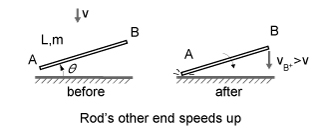Our chain: Design and Experiments
The idea behind the chain we
built. Other ideas for chains that pull-in are in the paper.
If one lets a tilted rod fall onto a table, its
other end speeds up on hitting (by 50% for a uniform rod with
small ? having plastic impact: VB+ =
3V/2).
(That's why things break on the 2nd bounce, see the cover
story in the Wall Street Journal, Friday Dec 17, 1993).

Devices
Chain: we made the chain with tilted rods as its links.
Release mechanism that drops the chain simulaneously.
High speed camera. Phantom V7.1 camera at 2000 fps.
Making the Chain
We used two essentially identical chains made of dowels tied together with Vectran. The weights of the two chains were 218g (plus or minus 2 g).

Trigger-Release Mechanism
Originally an electromegnetic release was used. It didn't work well. The magnetic field stayed on briefly even after turning off the current, and this was hard to control between the two magnets.
Finally a mechanical release was devised and built as shown below:

2. Hang the chains from the release posts (A).
3. Cut the zip-tie (like pulling a trigger).
4. Spring retracts, releasing the chain and object.
Download (351MB)
Results: Chain falls faster than gravity!
The chain on the table falls faster than the one in air. In the leftmost frames, at release, the bottoms of the chains were 75cm above the table. In the rightmost frames the chain on the left has pulled ahead by about 6-7 cm.

The chain on the table (on left) falls faster than chain in air
To make sure the chains were essentially the same in behavior, the experiments were repeated with the chains swapped. Again the chain on table ended up ahead by 6-7cm.
Videos:
|
|
|
(57sec@ 2000 fps in.mov format) low (1.5MB) med (6.2MB) high (673 MB)
(32sec @ 2000 fps in .mov format) Chains swapped. low (2.0MB) med (19.4MB) high (388 MB)
Problems faced
- Air friction. Drag is different between a chain and, say, an apple. So we compared two identical chains.
- Elastic contraction. When a chain is released the tension in the chain drops nominally to zero. Because the chain always has some elasticity, this drop to zero starts an overall chain contraction that continues as the chain falls. This elastic contraction pulls the top of the chain down, making it go faster. Again, using identical chains made this effect the same in both.